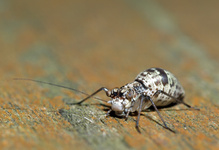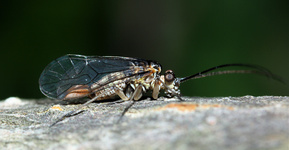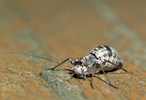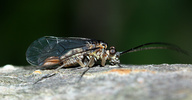Mesopsocidae
Emilie Bess and Kevin P. Johnson- Acmomesopsocus
- Aphanomesopsocus
- Conomesopsocus
- Cyrtopsochus
- Hexacyrtoma
- Idatenopsocus
- Mesopsocidus
- Mesopsocopsis
- Mesopsocus
- Metapsocus
- Microtrichipsocus
- Newipsocus
- Oegomesoposcus
- Psoculidus
- Psoculus
- Rhinopsocus
Introduction
The family Mesopsocidae contains about 74 species in 12 genera distributed worldwide, with highest diversity in tropical Africa and Eurasia. Three species are known from North America in the genus Mesopsocus.
Mesopsocids are medium-to-large sized bark lice (3-4.5 mm, nymphs up to 4 mm). Sexual dimorphism is common in this family: males are slender and winged, females are stout with short wings or wingless, and much larger than the males. Mesopsocids inhabit bark and stone surfaces, and one species has been associated with termite nests.
Characteristics
Synapomorphies
Epistomal suture of head had a broad internal ridge.
Forewing suface lacks hairs on margins, veins, and membrane.
Female: ventral valve of gonapophyses is broad apically and pointed.
General Characters
- Head:
- Antennae have 13 segments.
- Legs:
- Tarsi have 3 segments.
- Wings:
- Wing dimorphism is common: males with long wings, females with short wings or wingless.
- Forewing veins with "Caecillius" pattern: Areola postica is free of vein M.
- Forewings are hairless.
- Hindwing:
- Hindwing veins Rs and M are fused at base.
- Margin has hairs between veins R2+3 and R 4+5 only.
- Hindwings are hairless.
- Male:
- Hypandrium is simple, not ornamented.
- Phallosome external parameres are broad (about 1/3 length of phallosome) and often slightly bilobed.
- Phallosome tip has light sclerotizations.
- Female:
- Subgenital plate has a single posterior lobe with distal process.
- Gonapophyses are complete and well developed:
- Ventral valve is pointed and broad apically.
- Dorsal valve is broad or rectangular.
- External valve is rounded and hairy.
How to Know the Family
- Medium-to-large sized bark lice, 3-4.5 mm.
- Body form varies from slender with long wings to stout and wingless.
- Body is nearly hairless.
- Tarsi have 3 segments.
- Forewings are hairless.
- Forewing areola postica is free from vein M.
- Hindwing margin has hairs between veins R2,3 and R 4,5 only.
Family Monophyly
Family monophyly is supported by three unique characters: wing surface lacking hairs, the epistomal suture on the head with a broad internal ridge, and, on the female genitalia, the ventral valve of the gonapophyses apically broadened (Yoshizawa 2002). Molecular phylogenetic study has supported the monophyly of two species of Mesopsocus, but monophyly of the family with respect to genus Idatenopsocus was unclear (Johnson et al. 2004).
Discussion of Phylogenetic Relationships
Relationships within the family Mesopsocidae have not been studied in detail. Mesopsocidae has traditionally been included in superfamily Homilopsocidea and this placement of genus Mesopsocus is supported by molecular data (18S nDNA, Johnson et al. 2004). Morphological data support a sister relationship between Mesopsocidae and Philotarsidae, based on two characters: the hindwing margin with hairs between veins R2+3 and R 4+5 only, and, in the male, a rounded apex of the phallosome (present in some Mesopsocidae and considered the “ground plan” for the family) (Badonnel and Leinhard 1988, Yoshizawa 2002).
References
Badonnel A, Lienhard C. 1988. Révision de la famille des Mesopsocidae (Insecta: Psocoptera). Bulletin du Muséum national d’Histoire naturelle 4, 2: 375–412.
Johnson, K. P. & E. L. Mockford. 2003. Molecular Systematics of Psocomorpha (Psocoptera). Systematic Entomology 28: 409-40.
Johnson, K. P., K. Yoshizawa, and V. S. Smith. 2004. Multiple origins of parasitism in lice. Proceedings of the Royal Society of London B 271:1771-1776.
Lienhard, C. and C. N Smithers. 2002. Psocoptera (Insecta) World Catalogue and Bibliography. Muséum d'Histoire Naturelle, Geneva, Switzerland.
New, T.R. 2005. Psocids, Psocoptera (Booklice and barklice), 2nd edition: Handbooks for the Identification of British Insects. Vol. 1, Part 7. Royal Entomological Society, London, UK.
Mockford, E. L. 1993. North American Psocoptera (Insecta). Gainesville, Florida: Sandhill Crane Press.
Mockford, E. L. 2007. Species of Philotarsus from north and middle America and a new Philotarsine genus from Mexico, Guatemala, and the Greater Antilles (Psocoptera: Philotarsidae: Philotarsinae). Journal of the New York Entomological Society 114: 108-139.
Smithers, C. N. 1996. Psocoptera. Pp. 1-80, 363-372 (Index) in Wells A. (ed.) Zoological Catalogue of Australia. Vol. 26. Psocoptera, Phthiraptera, Thysanoptera. Melbourne: CSIRO Publishing, Australia.
Yoshizawa, K. 2002. Phylogeny and higher classification of suborder Psocomorpha (Insecta: Psocodea:'Psocoptera'). Zoological Journal of the Linnean Society 136: 371-400.
Title Illustrations

| Scientific Name | Mesopsocus unipunctatus |
|---|---|
| Specimen Condition | Live Specimen |
| Identified By | K. Yoshizawa |
| Sex | Female |
| Life Cycle Stage | micropterous adult |
| View | anterolateral |
| Size | 3mm |
| Copyright | © 2006 Kazunori Yoshizawa |
| Scientific Name | Mesopsocus unipunctatus |
|---|---|
| Specimen Condition | Live Specimen |
| Identified By | K. Yoshizawa |
| Life Cycle Stage | adult |
| View | lateral |
| Size | 4mm |
| Copyright | © 2006 Kazunori Yoshizawa |
About This Page
Emilie Bess

Illinois Natural History Survey, Champaign, Illinois, USA
Kevin P. Johnson

Illinois Natural History Survey, Champaign, Illinois, USA
Correspondence regarding this page should be directed to Emilie Bess at
bess@inhs.uiuc.edu
and Kevin P. Johnson at
kjohnson@inhs.uiuc.edu
Page copyright © 2009 Emilie Bess and Kevin P. Johnson
All Rights Reserved.
- First online 25 March 2009
- Content changed 25 March 2009
Citing this page:
Bess, Emilie and Kevin P. Johnson. 2009. Mesopsocidae. Version 25 March 2009 (under construction). http://tolweb.org/Mesopsocidae/14480/2009.03.25 in The Tree of Life Web Project, http://tolweb.org/










 Go to quick links
Go to quick search
Go to navigation for this section of the ToL site
Go to detailed links for the ToL site
Go to quick links
Go to quick search
Go to navigation for this section of the ToL site
Go to detailed links for the ToL site